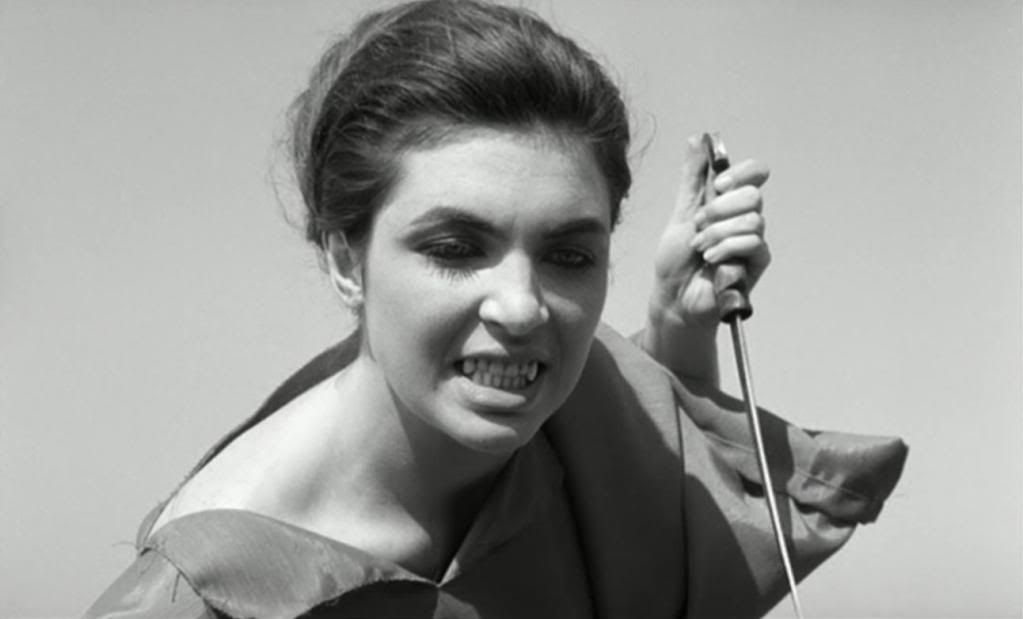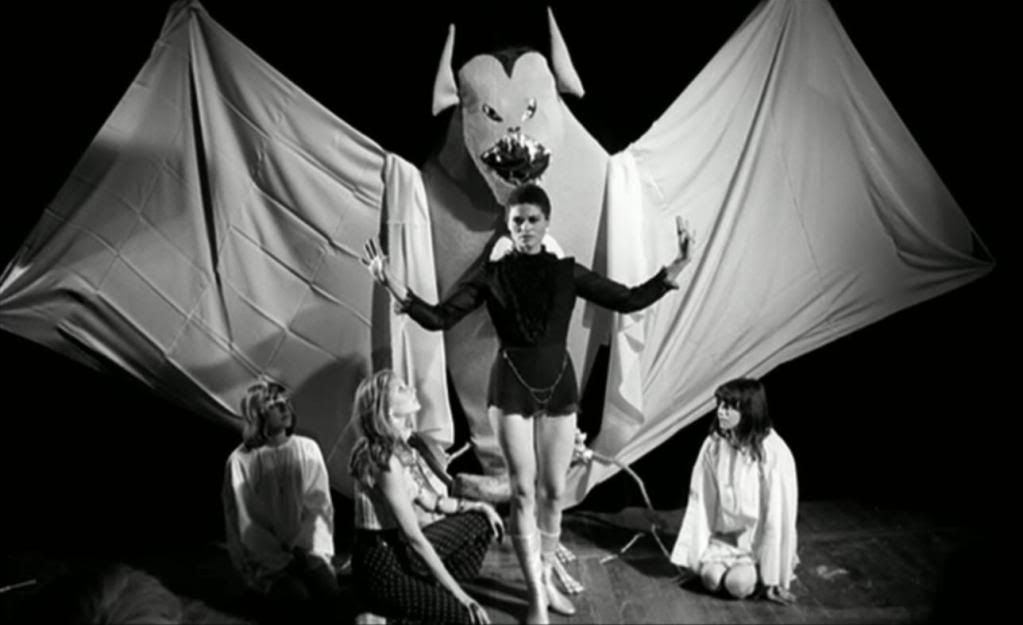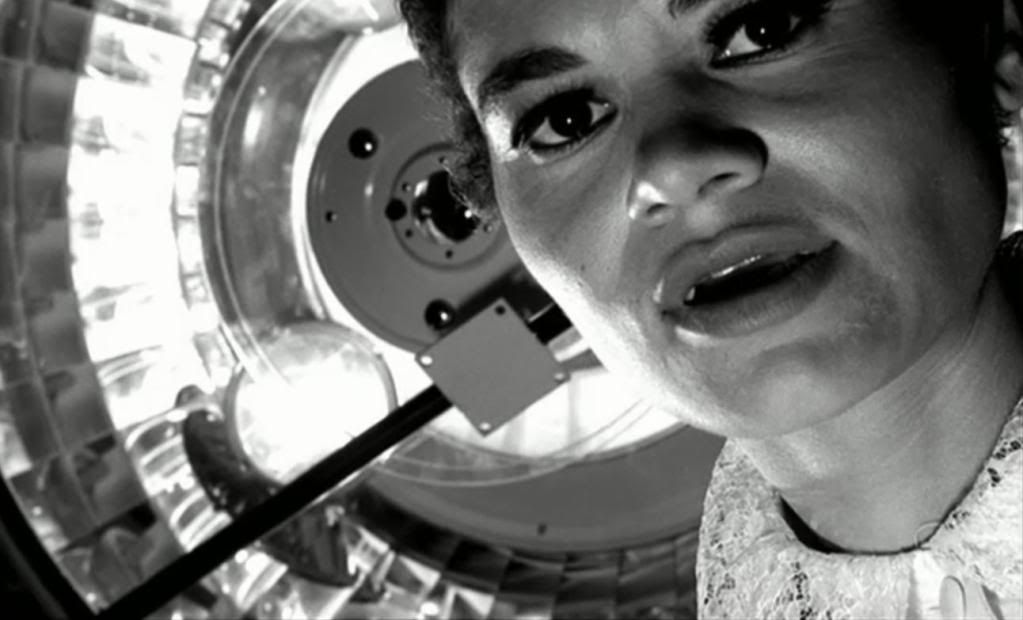

Jean Rollin's first feature, The Rape of the Vampire, establishes virtually all of the templates for this trash auteur's distinctive approach to no-budget sexploitation horror. Surreally dreamlike and strange, with a plot that never makes a shred of sense, Rollin's film wanders dreamily from one set piece to another, the connections between them as ephemeral as the neural pathways linking one moment to another in a dream. This debut was shot in black-and-white, and though a bright, garish color sensibility is integral to the director's later work, the color is hardly missed here, as he crafts an equally potent, moody aesthetic in stark sun and shadow.
The film is actually split into two unequal parts, and though the story, such as it is, continues more or less seamlessly from one part to another, they're definitively split apart and there's even a second credits sequence that runs before the second part begins. The bridge between the two parts of the film is like crossing from the real world, where a rational explanation, however unlikely, is still possible, to the truly unhinged world of the surreal, the nightmarish, the supernatural, where rationality is utterly banished and the semblance of a plot is all but entirely erased.
In the first third of the film, the psychoanalyst Thomas (Bernard Letrou) and his friends visit a remote village supposedly haunted by four vampire sisters. Thomas doesn't believe the sisters are actually vampires, he thinks they've just been manipulated into thinking they are, and he seeks to cure them of their delusion. He even seems to be right: the sisters worship before a pagan altar and are given orders by their god, who turns out to be an old man from the village, hiding behind the altar, delivering instructions to the women for his own mysterious purposes. This segment ends with virtually everyone dead, climaxing at the bleak-looking beach, with wooden posts like prison bars, that Rollin would return to again and again in his oeuvre. That beach is a conduit into the unknown, and as the film transitions into the second segment that constitutes its final two-thirds, the rational explanations and pseudo-scientific jargon of the first part are jettisoned in favor of an enthusiastic embrace of the supernatural.


This shift is announced especially by the arrival of the Queen of the Vampires (Jacqueline Sieger), a campy and outrageous figure who's constantly baring her fangs and laughing sinisterly, often without any context whatsoever: Rollin seems to love cutting to her in mid-cackle. The Queen's plans are typically hazy, but there's lots of grave-robbing, hypnotized girls hooked up to tanks of blood from which the vampires drink through long straws, sinister operations and rituals, a vampire priest holding an upside-down cross, and so on. The film's imagery is wild and weird, climaxing with a very chintzy vampire wedding that looks like the vampires are actually staging an amateur play: it's set on a stage with a huge and clumsily constructed bat in the background, its wings seemingly made from bedsheets.
There's a strong element of theatricality in Rollin, certainly, a sense that these vampires are performing for someone, maybe just for one another. The vampires even repeat the trick that the old man had pulled in the first part of the film, setting up an altar that seems to be speaking to some vampire supplicants, but actually houses a tape recorder playing back a loop of the Queen's voice. The supernatural is very ordinary in Rollin's world, the artifice paper-thin. There's little boundary between the real and the unreal, and the rough, clumsy low-budget aesthetic lays bare the artificiality of it all. There's a raw, one-take feel to much of the film: if a statue falls off a shelf and nearly hits the vampire queen in the head as she descends on a reclining victim, no matter, it's good enough, and Rollin leaves in this unscripted accident. The blood wedding, with its amateur drama club feel, is another good example; the vampires for some reason feel the need to stage their rituals with shoddy dramatics and awkwardly constructed props, performing for an audience of other vampires, who sit playing bongos in the theater seats and storm the stage for an impromptu celebration at the climax of this "play."
That's the essence of Rollin right there, the real and the unreal, the theatrical and the seemingly unstudied, the supernatural and the ordinary, colliding within his utterly idiosyncratic cinema. He presents a fractured and nonsensical dream world that leaps without warning from one thing to another at the speed of thought, giving the impression of a film edited according to the momentary whims of the dreamer. Action can jump suddenly from one location to another without warning or narrative justification, and the connections between scenes are often, let's say, mysterious. Even the seedy eroticism that always characterizes Rollin's work follows this (il)logic: women are rarely seen taking their clothes off in this film, instead leaping effortlessly from clothed to naked in between shots. All of this combines to make Rollin a true poet of trash, locating a strange kind of unsettling poetry and even beauty in his outrageous dream world.
Great stuff Ed. I really enjoyed reading your perceptive thoughts of Rollin's first feature. I hope you might post on some of his other works in the future as well.
ReplyDeleteThanks, Jeremy. I've been watching a lot of Rollin recently, I'll be posting about him all year at the rate I'm going! My favorite so far is probably Lips of Blood.
ReplyDeleteIt took me a while to finally get into him, but your raves about Rollin were what first put him on my radar. I've been going through the archives of your Fascination blog lately as I watch all these, it's been very informative.
I was most intrigued by the dreamy FASCINATION Ed, but I haven't further explored the Rollin catalogue. This is quite the remarkable essay that has me thinking I need to look at more of this prolific artist's work, especially since it's largely in a favored genre.
ReplyDeleteFascination is really good. As I mentioned, I've been watching lots of Rollin lately and really enjoying it all. He's definitely worth exploring in depth. In addition to this fine debut, I'd heartily recommend Lips of Blood, Requiem for a Vampire, and The Grapes of Death (which wins for best title, surely) as some more of his best. I love his mix of crude exploitation, poetic abstraction and dreamy surrealism.
ReplyDeleteOh, dear Jean Rollin, one of the masters of trash art. Requiem for a Vampire is one of the great trash masterpieces because it plays as if the cast are in a trance, an erotic dream on forbidden substances. Also very fond of Lips of Blood, The Iron Rose and The Grapes of Death. Fascination also has Brigitte Lahaie in her best non hardcore role, wielding a scythe. Magic! I need to get some more of his Blu Rays in time.
ReplyDeleteAnd if you can track it down, his XXX Phantasmes, while an awful print, and essentially utter trash, has a bizarre sort of fascination about it. Not to mention those ultra-weird Castel twins getting up to no good.
ReplyDeleteThis most interesting overview of Rollin appeared in SLANT last year:
ReplyDeletehttp://www.slantmagazine.com/film/feature/flesh-and-blood-the-cinema-of-jean-rollin/301
Really nice review here Ed of a director oft forgotten since he worked in such a niche subgenre, so niche in fact that it's almost a sub-subgenre. Earlier in the year when Slant did a piece on his blu-rays coming out (that Sam has linked to above) I said this in an email exchange with several of Wonder's regulars: "Unbelievable, Jean Rollin is getting art house bluray treatment. Wow, opinions will sway now in his direction a bit. Here's a lesson in how commerce directs cultural tastes and opinions." And sure enough I've seen essays on his films popping up more and more around the internet. None better than what you offer here. I'm think the new Fernando Di Leo box of his crime films will do the exact same thing for his career.
ReplyDeleteI've never seen Fascination but will now remedy that. I do count Lips of Blood to be my favorite of the 4 or 5 of his I've seen.
When's the review of Franco's Faceless coming? lol
Agreed on all of those, Allan, though I still need to see The Iron Rose, which sounds great. I'd say Lahaie's best performance is Night of the Hunted, even though that's only about half of a good movie. She has such vulnerability and softness in that movie, very different from the raw, unhinged violence she projects in her other Rollin roles.
ReplyDeleteSam, yes, that Slant overview is very good. Any Rollin fans should also check out the dedicated blog of Jeremy Richey (who commented above) which has a wealth of Rollin info and tributes.
Jamie, I've long intended to check out Rollin, but the recent availability of a whole bunch of his films via Netflix Instant made that a lot easier. Commerce, and availability, definitely mean a lot when it comes to filmmakers' reputations.
I've never seen any Franco, but I do intend to fix that eventually. I have a feeling, though, that it'll be hard for any other Eurotrash director to top the quite distinctive sensibility that Rollin has, which makes his films so much more than the trashy horror they might've been.
Yes, exactly, not sure Franco has a style, but Justine is worth watching purely for Akim Tamiroff's dirty old man and Bruno Nicolai's score.
ReplyDeleteYes, liked Lahaie in Night of the Hunted, though it's not major Rollin. Major Rollin needed vampires.
Jesus Franco isn't really anything, I could watch only about 4 of his movies for the rest of my life and be pretty content. There is a weird Spanish religiosity to his works that would be the 'deeper' perspective (akin to Rollin's surreal dreamlike flare), but it very rarely comes off as anything resembling subtle.
ReplyDeleteI always recommend FACELESS because it's intensely violent (and somewhat sadistic), unlike pretty much everything he ever did (plus if you like the art-horror of EYES WITHOUT A FACE, it's funny to see what Franco takes that story as). So if you dislike it you might like other Franco, or if you like it you might not like Franco. If that makes any sense.
That and somewhere, sometime, someone will write a piece comparing the recent Portman vehicle BLACK SWAN with Franco's 1970 NIGHTMARES COME AT NIGHT. They just BEG to be compared and contrasted.